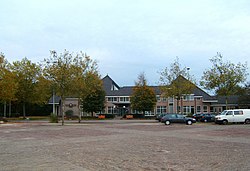Staphorst
| Staphorst | |||
|---|---|---|---|
| Municipality | |||

Staphorst city hall
|
|||
|
|||
 Location in Overijssel |
|||
| Coordinates: 52°39′N 6°13′E / 52.650°N 6.217°ECoordinates: 52°39′N 6°13′E / 52.650°N 6.217°E | |||
| Country | Netherlands | ||
| Province | Overijssel | ||
| Government | |||
| • Body | Municipal council | ||
| • Mayor | Theo Segers (CU) | ||
| Area | |||
| • Total | 135.69 km2 (52.39 sq mi) | ||
| • Land | 134.22 km2 (51.82 sq mi) | ||
| • Water | 1.47 km2 (0.57 sq mi) | ||
| Elevation | 1 m (3 ft) | ||
| Population (February 2017) | |||
| • Total | 16,396 | ||
| • Density | 122/km2 (320/sq mi) | ||
| Demonym(s) | Staphorstenaar, Staphorster | ||
| Time zone | CET (UTC+1) | ||
| • Summer (DST) | CEST (UTC+2) | ||
| Postcode | 7715, 7950–7955 | ||
| Area code | 0522 | ||
| Website | www |
||
Staphorst (![]() pronunciation ) is a municipality and a town in the eastern Netherlands.
pronunciation ) is a municipality and a town in the eastern Netherlands.
The villages of Staphorst and its southern neighbour Rouveen came into existence as in the 13th century monks started to bring the bogs and swamps into culture.
All the farms were built along the long road through the bog area. Thus a lengthy row of farms was built, becoming the 11 km (7 mi) long village of Staphorst-Rouveen. This phenomenon is called in Dutch: lintbebouwing (ribbon urbanization). In many parts of the Netherlands this type of village is quite common, e.g. Vriezenveen, the villages along river dykes in the Netherlands, the so-called moor-colonies in the provinces Drenthe and Groningen, as well as the German regions opposite the border.
According to the website goDutch.com in the section of "Excerpts from the Windmill" in the entry for "Staphorst reunion organizers eager to welcome former residents for April 2011 municipal bicentennial", Staphorst was a Dutch municipality, created through a decree by French emperor Napoleon who merged four smaller entities into a much larger one. The 1811 decree merged the villages of Rouveen, Staphorst and IJhorst along with nearby sparsely populated Hasselter schoutambt (a judicial entity) into a municipality, known since 1818 as Staphorst. Except for a few minor changes, Staphorst's borders have remained unchanged, making it an anomaly in Dutch municipal history.
A specialty for Staphorst is, that after a farmer's death, his land was often divided between his sons. The son who didn't inherit his father's farm built a farm-house for his own behind the other. Therefore, many pieces of farmland are very lengthy, yet narrow (e.g. 1500 x 40 metres). Originally, each piece of land was 125 metres wide.
...
Wikipedia


